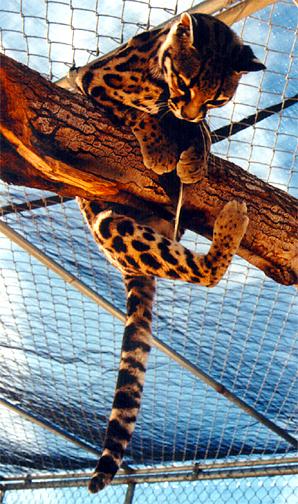
Stamped for your approval
Leopardus weidii
So...Where do I fit in? Classification
|
|
|
|
Domain- Eukarya
| Organisms within Eukarya have membrane bound organelles such as a nucleus or mitochondria. |
Kingdom- Animalia
| The Kingdom Animalia is comprised of multicellular organisms that are motile, heterotrophic, and lack cell walls. |
Phylum- Chordata
| Organisms here have what is known as a notochord during fetal development. This structure is a long rod-like tube that runs along the dorsal portion of the organism and typically disappears by birth. A notochord should not be confused with a backbone, vertebrae, or vertebral column, however, since many non-vertebrates are classified as chordates. |
Class- Mammalia
| Here organisms are characterized by the presence of an assortment of glands, including sweat glands and mammary glands. They also have bodies covered in hair, are warm-blooded, and give birth to live young. |
Order- Carnivora
| Distinguished by the high prevalence of meat as the primary energy source in their diet. Carnivores may either be predators, meaning they hunt and eat living organisms, or scavengers, meaning they eat organisms which are already dead. |
Family- Felidae
| Members of this group are what one commonly thinks of as cats, these animals are characterized by retractable claws, living a typically solitary lifestyle, and engaging in stealthy hunting techniques. |
Genus- Leopardus
| This category of cats includes spotted cats inhabiting the Americas. |
Species- wiedii
| Refers to the small, spotted cat which is intermediary in size between the ocelot and the oncilla... the margay. |

| Original Tree- created by Jeremy Knoble |
|
The Great Genus Leap As eluded to before, the margay has been "moved!" Once found as a subgenus of Felis rather than as its own genus, Leopardus contains spotted cats inhabiting Central and South America, all of which are described as lesser cats. Lesser refers strictly to the cats small stature in comparison with other members of the family Filidae. The major factor allowing Leopardus to form its own genus came with the discovery of the group's unique chromosomal count. Cats primarily have 38 chromosomes making up their genome, but those found in Leopardus contain only 36. This is thought to be the result of two chromosomal pairs fusing in an extinct relative of the species, which leads to a fairly certain grouping of these cats phylogenically. Thus, you have Leopardus! |
 Made it! Maggie the margay. Picture, used with permission, by Nancy Vandermey |
Leopardus Table
|
Scientific Name |
|
 |
Copyright © 2007, Design by: Sunlight webdesign
